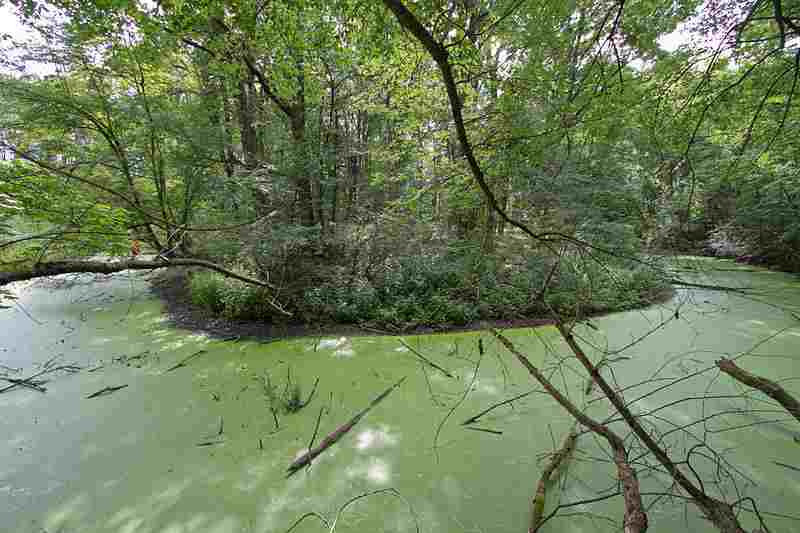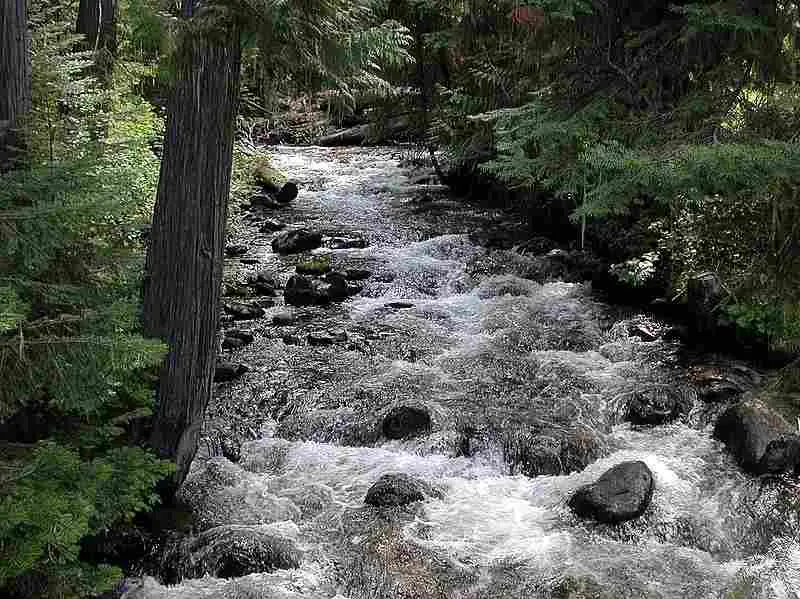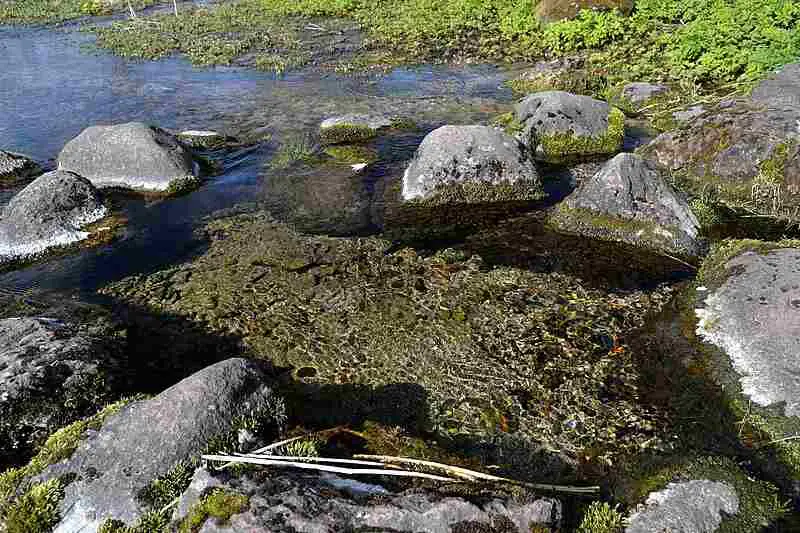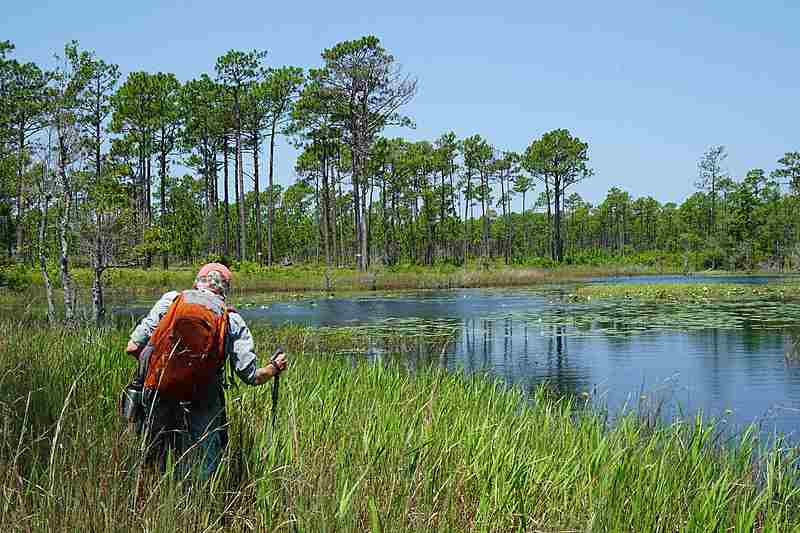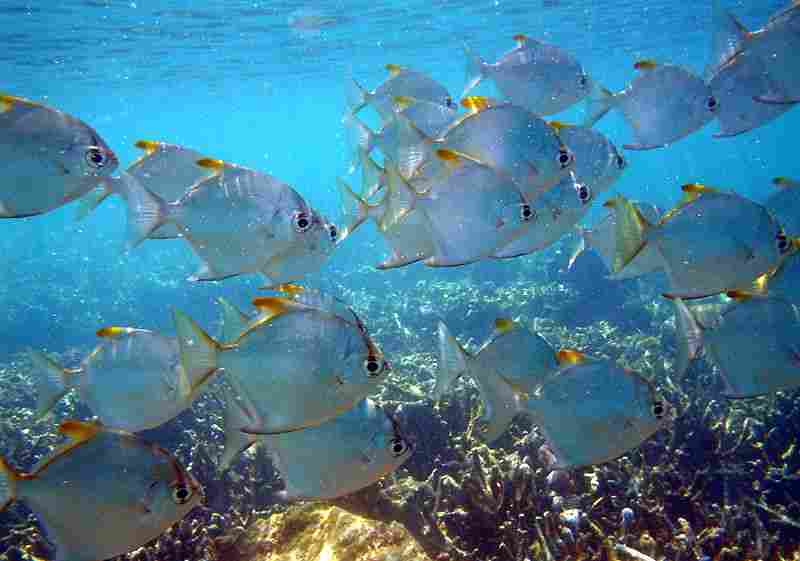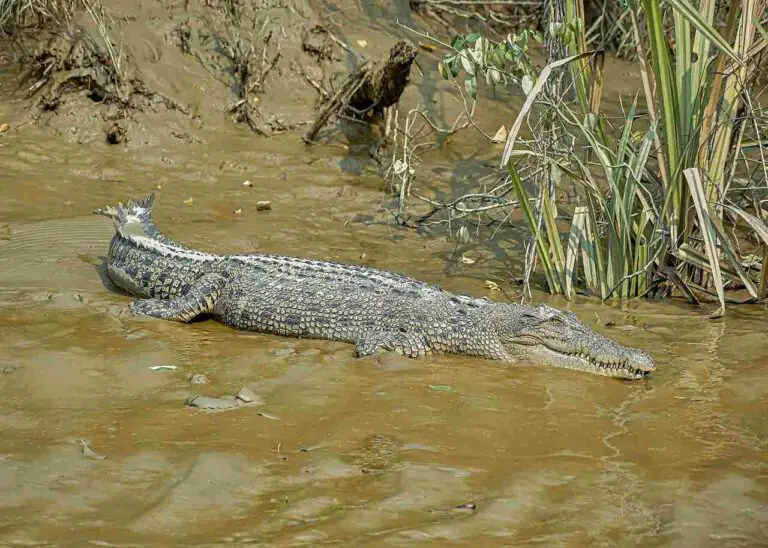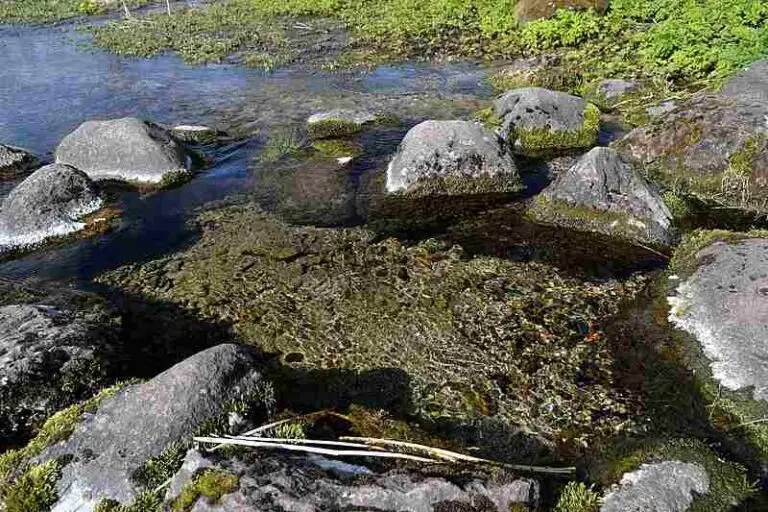9 Abiotic Factors in a Swamp Ecosystem Discussed
Abiotic factors in a swamp ecosystem are; light, water, dissolved gases, nutrients, sediments, rocks, physicochemical parameters, underwater topography, hydrology and flow conditions.
This article discusses the abiotic factors in a swamp ecosystem and their ecological importance, as follows;
1). Light (as one of the Abiotic Factors in a Swamp Ecosystem)
Light is a key abiotic factor in a swamp ecosystem, known for its fundamental contribution to shaping the ecosystem's dynamics and supporting its biotic components.
Importance of Light in a Swamp Ecosystem
The importance of light in a swamp ecosystem can be attributed to its involvement in photosynthesis, plant growth and productivity, food chain/web dynamics, and habitat structural sustainability.
In photosynthesis, light is a primary source of energy that is required to both initiate and sustain the process, which involves converting solar radiation (visible light portion of the solar electromagnetic spectrum) into chemical energy [8].
Light defines the interconnectivity of abiotic and biotic components in semi-aquatic/aquatic ecosystems like swamps. Plants such as submerged hydrophytes and emergent plants, rely on light to produce their food.
Photosynthesis constitutes the foundation of the food chain, as it leads to the production of energy-rich biomass that is the primary medium of energy transfer between organisms.
Growth and productivity of plants in swamps, are directly influenced by light availability.
Adequate light levels imply that plants can photosynthesize and produce biomass at an optimal rate, and with relatively-optimal efficiency. Different species of plants have varying light requirements [2], which lead to a diverse plant community on the basis of light dependency/utilization.
Bioenergy derived from photosynthesis, is transferred through the trophic levels of the food web, where it supports herbivores, carnivores, and decomposers, following a natural hierarchical pathway. Primary consumers, such as herbivorous mammals and insects, rely on plants as a primary food source, while predatory animals higher up the food chain depend on the stored-energy from plants, in these herbivores.
Habitat structure of the swamp ecosystem is shaped by light, among other factors. Light-supply dynamics, influence plant density, composition and distribution. The penetration of sunlight through the swamp-water column affects the growth of aquatic plants and the behavior, species richness, navigation, and abundance of aquatic organisms; which are all key aspects of the aquatic ecosystem structure.

How Light Is an Abiotic Factor in the Ecosystem
Light is considered an abiotic factor because it is an inorganic, non-living component that influences the living organisms in the ecosystem. Unlike biotic factors that involve organic compounds and interactions between living organisms, abiotic factors like light are not organic, but exert direct influence on organisms.
In the swamp ecosystem, light is not a living entity, however its presence and variability drive biological processes. Light influences the growth, distribution, behavior, and overall biological success of plants and animals.
As an abiotic factor, light continuously interacts with other abiotic factors such as temperature, nutrients and water, to determine the overall functionality and health of the ecosystem.
2). Water
Water is a foundational abiotic element in a swamp ecosystem, with multiple vital contributions to the sustenance of this unique habitat.
The importance of water in swamps can be highlighted in terms of its involvement in habitat provision, biodiversity management, nutrient-recycling, primary production, temperature regulation, hydration and organic survival, as well as habitat heterogeneity.
Water is the defining feature and component of a swamp ecosystem. It provides an ambient environment/habitat for a diverse range of organisms, including amphibians, reptiles, aquatic plants, insects, mammals, and birds. Multiple species have evolved specialized adaptations that enable them thrive in the wet and aquatic conditions of swamps.
Nutrient cycling is another important function of water, which serves as a flexible medium for nutrient cycling and transport within the ecosystem.
Water transports organic materials and dissolved nutrients from one point or area to another, in such a manner that facilitates the growth of aquatic plants and supports the food web/energy pyramid.
Primary production through photosynthesis, relies on water as an essential raw material, for conversion of light energy into chemical energy. Aquatic plants that grow in swamps, utilize water to carry out photosynthesis by which they produce organic compounds that constitute the foundation of the food chain.
Because water has a high heat capacity [1], it is capable of absorbing and storing significant amounts of heat. In swamp ecosystems, water helps in thermo-regulation by moderating temperature fluctuations. This creates a more suitable and stable environment for organisms.
The survival of swamp species depends directly and immensely on water, which is involved in various metabolic and physiological processes. Several animals rely on water for acquiring food and maintaining proper hydration levels.
Lastly, the presence of water helps to create distinct microhabitats within the swamp ecosystem. These include submerged zones, waterlogged soils and open water areas. Diversity of habitats translates to diversity of species, because it supports variety and niches specialization of organisms with different ecological requirements.
Status of Water as an Abiotic Factor
Water is considered an abiotic factor because it is a non-living, inorganic material that plays important role(s) in the ecosystem and influences the both organisms and processes. In swamps, water is the ambient medium that provides the required physical and chemical conditions for life.
Water also interacts with other abiotic factors in a swamp such as pH, nutrients, light and temperature, to create a complex web of trophic relationships.
The water level, quality and flow-trend, all determine which species can thrive, and contribute to the overall stability of the ecosystem.
3). Dissolved Gases (as one of the Abiotic Factors in a Swamp Ecosystem)
Dissolved gases, especially dissolved oxygen (DO), play a major role as abiotic elements in a swamp ecosystem. Like other elements in their category, these gases influence various ecological processes, and are instrumental to the survival of aquatic organisms.
Importance of Dissolved Gases in a Swamp Ecosystem
Respiration and general metabolism of aquatic organisms, including microorganisms, macroinvertebrates and fish, are driven by dissolved oxygen [4].
DO is essential for the metabolic processes that produce required energy for growth, reproduction and mobility.
Organic matter in the swamp ecosystem serves as a food source for decomposers, some of which are aerobic.
Aerobic biodegradation is facilitated by the availability of oxygen to microbes. This dissolved gas energizes microbial cells, enabling them to break down organic material, and contributing to nutrient cycling with the release of essential elements back into the water column.
Biotic interactions in a swamp also thrive with sufficient oxygen, as dissolved oxygen levels control the behavior and distribution of aquatic organisms. Species diversity, abundance and composition, can all vary on the basis of DO concentrations, which shape community interactions and trophic conditions.
Adequate levels of DO can help prevent or mitigate eutrophication, a process whereby excessive nutrients in water lead to algal blooms and significant oxygen depletion [3].
Even in the presence of surplus nutrients, maintaining high DO levels, supports a healthier aquatic ecosystem and prevents oxygen-stressed conditions.

Dissolved oxygen can be effectively used as an indicator of water quality.
Low DO levels are indicative of potential water pollution by excessive nutrient input or other stressors, prompting efforts at remediation, water conservation and mitigation of environmental impacts.
Availability of habitat for swamp species is also affected by dissolved oxygen, due to differences in oxygen requirements for different organisms.
Some species are adapted to lower DO conditions, while other can only survive with higher oxygen supply. Changes in DO can lead to shifts in the suitability of various swamp-zones for habitation.
Status of Dissolved Gases as Abiotic Factors
Dissolved gases, such as carbon dioxide and oxygen, are classified as abiotic factors because they are inorganic and non-living, influential components of the ecosystem.
These gases are integral to the biogeochemical cycling of elements that impact ecological interactions, and are at the core of carbon, nitrogen and oxygen cycles, among others.
In a swamp ecosystem, abiotic factors like temperature, nutrients, and light, affect the concentration of dissolved gases. For example, warmer water temperatures can decrease oxygen solubility [6], thereby leading to lower DO levels.
Additionally, biodegradation rates and nutrient inputs can influence carbon dioxide concentrations, which in turn affect water quality and pH levels.
4). Nutrient
Nutrients, including minerals from the breakdown of organic compounds, are vital abiotic elements in a swamp ecosystem.
They influence primary productivity, growth, health and continuity of the biome.
Importance of Nutrients in a Swamp Ecosystem
The importance of nutrients in a swamp ecosystem include their contributions to autotroph growth, primary production, food web dynamics, decomposition and resource cycling, habitat formation, water quality and eutrophication, as well as redox potential.
Autotroph growth and primary productivity are both influenced by essential nutrients like nitrogen, potassium and phosphorus; which are fundamental for photosynthetic-growth and development. These nutrients are crucial components of plant enzymes, proteins, and other essential biological compounds. Nutrients support photosynthesis, cell development, and overall plant health [9].
Nutrients drive primary production in swamps, by providing autotrophs with the required resources for photosynthesis. Vascular and non-vascular plants, as well as algae, use nutrients to transform light energy and inorganic raw materials, into organic matter, to form the foundation of the food chain.
This implied that the availability of nutrients influences the composition and abundance of primary producers, which in turn affect the dynamics of herbivores and higher trophic levels. Nutrient availability can shape the structure of the swamp ecosystem, and impact the interactions of various species.
Decomposition is linked to nutrient cycling because it releases nutrients from organic compounds [5].
As organic matter is deposited from waste and animal/plant remains in a swamp ecosystem, microbial organisms act on these materials to release nutrients back into the sediments and water.
Nutrient cycling is a crucial process that ensures the continuous availability of nutrients for plant uptake and ecosystem functioning.
Habitats and shelter are formed by vegetation, whose growth is facilitated by nutrients.
Plants in a swamp help to stabilize soil, mitigate erosion, and create microenvironments that support a broad range of species.
Balanced nutrient levels are an important requirement for maintaining water quality. Excessive input of nutrients, particularly nitrogen and phosphorus, can result in eutrophication—excessive growth of plants and algae—which can disrupt water clarity, oxygen levels, and ecosystem.
Redox potential is a measure of oxidation-reduction conditions in a given environment [7]. This variable is related nutrient availability. Different redox conditions influence the mobility and solubility of nutrients, including their accessibility to plants and other swamp organisms.
Status of Nutrients as Abiotic Factors
Nutrients are considered abiotic factors in an ecosystem because they are inorganic and non-living components, which exert significant influence on their environment, including its living inhabitants. They interact with the biotic components to control ecological processes and community composition.
Nutrients are cycled through the ecosystem, moving between living organisms, water, soil, and the atmosphere in naturally-driven cycles that impact various biological and chemical processes.
5). Sediments (as one of the Abiotic Factors in a Swamp Ecosystem)
Sediments comprise of various sizes of mineralogical particles including clay, silt, and sand, which are essential abiotic factors in a swamp ecosystem.
They influence different ecological processes and serve important functions that maintain the overall health and functioning of the ecosystem.
Importance of Sediments in a Swamp Ecosystem
Sediments form the bottom-substrate of wetland habitats, providing a foundation for plants, invertebrates, and other organisms. Several species rely on sediment-rich areas for burrowing, foraging and nesting.

Nutrient storage (including carbon sequestration) is another function of swamp sediments.
These sediments can store both organic matter and nutrients, thereby serving as reservoirs of essential resources. Nutrients that are contained in sediments can be released back into the water column, where they contribute to the accessible nutrient-pool and support organic growth.
Adsorption and retention of pollutants by sediments can help to detoxify the swamp ecosystem, and mitigate the effects of such materials on water quality and aquatic life. The sediments play a role in detoxifying the environment through sequestration of harmful substances.
Large particles in sedimentary assemblages, help stabilize the banks of water bodies, reducing the rate and severity of erosion caused by water movement. The accumulation of such sedimentary material along shorelines can protect smaller sediments against wave action, and promote the growth of vegetation.
The hydrology of wetlands is influenced and regulated by sediments, through their influence on water retention, groundwater recharge, and drainage. Sediments can act as natural sponges that absorb excess water during periods of flooding, and release the stored water gradually during dry spells.
Lastly, sediments serve as a substrate for microbial communities that are important to biogeochemical processes like decomposition and nutrient cycling. Microbes in sediments help in recycling nutrients.
Sediment as an Abiotic Factor
Sediments are considered abiotic factors in an ecosystem, because their core components are rock fragments and mineral grains, which are inorganic and non-living.
Abiotic factors are non-living components that regulate the environment, and influence the survival/performance of living organisms.
Sediments also interact with both biotic and other abiotic components in the swamp ecosystem.
6). Rocks
Rocks, as abiotic components within a swamp ecosystem, may not be as prominent or recognized as some other elements, but they still play a notable role in the regulation of environment and ecological processes.
Importance of Rocks in a Swamp Ecosystem
The importance of rocks in a swamp ecosystem, range from their contribution to physical structure, erosion control, habitat diversity, and mineral contribution; to their roles as algae substrate and source(s) of scientific information.
Pocks provide structural support to the physical framework of the swamp ecosystem, both above and below the water's surface.
They can form microhabitats for various organisms, platforms for aquatic vegetation, and perching/thermoregulation sites for animals, among others.
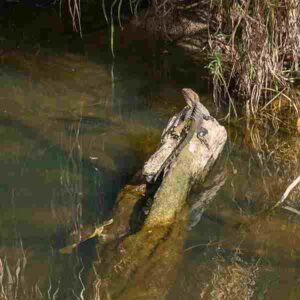
Erosion control is another function that can be attributed to rocks in swamps and other wetland biomes, especially in hydrologically-active zones, in streams and along shorelines.
In such zones, water is a potent agent of erosion that can displace sediments in significant magnitude and a rapid pace. Rocks can act as natural, mechanic barriers that protect the swamp ecosystem from the full impacts of currents and waves.
Diverse microhabitats are created by rocks, for a variety of organisms. Small crevices in rocks, and spaces between rocks can serve as inhabitable refuge for fish, amphibians and aquatic invertebrates, among others.
As rocks are subjected to weathering over time, they release minerals into the surrounding water. These minerals contribute to the nutrient content of the water column, having influence on nutrient cycling and plant growth.
Rocks can also serve as substrates for algal growth. Algae attached to rocks, are autotrophs that contribute to the food web by providing a source of nutrition for detritivores and some wetland grazers.
Aesthetic and scientific value can be attributed to rocks in a swamp ecosystem.
Some of these rocks add to the aesthetic appeal of the environment, and its recreational prospects. Studying the rocks can also reveal information about geological processes in the region.
How A Rock is an Abiotic Factor
A rock is an abiotic factor because it is comprised of non-living, inorganic minerals.
Like a typical abiotic factor, rocks influence multiple aspects of their environment including the landscape, nutrient-dynamics and hydrology of swamps and other ecosystems.
They interact with both biotic and other abiotic components (such as air, water, and soil) to sustain the ecosystem.
7). Physicochemical Parameters (as one of the Abiotic Factors in a Swamp Ecosystem)
Physicochemical parameters are essential variables in a swamp ecosystem that define and influence its overall structure, composition and sustainability.
These parameters encompass a broad range of physical and chemical attributes that describe the environmental conditions within the ecosystem.
Sn understanding of the effects and interactions of physicochemical parameters; is therefore vital for evaluating the dynamics and health of a swamp ecosystem.
Key Physicochemical Parameters in a Swamp Ecosystem
The key physicochemical parameters in a swamp ecosystem include; temperature, pH, dissolved oxygen, salinity, nutrient concentration, turbidity, and redox potential.
Temperature affects the rate of metabolism in organisms [10], and influences their growth, adaptation and reproduction. It also affects the rate at which chemical reactions occur in the ecosystem.
pH (Acidity, Alkalinity) levels influence the solubility of nutrients in the water column. It also affects the distribution, survival, species richness and abundance of aquatic populations, as different species are tolerant of specific pH levels/ranges, and intolerant of others.
Dissolved Oxygen (DO) is an essential parameter for the survival of aquatic organisms in swamps. It drives the oxygen cycle and other nutrient-related phenomena, and influences the respiratory processes of plants and animals.
Salinity levels determine the organisms that can effectively inhabit the ecosystem. Swamps with varying degrees of salinity will support different assemblages of species.
Nutrient Concentrations (including Nitrogen, Phosphorus), influence plant growth and primary productivity. Excessive amounts of nutrients can cause eutrophication, and altered ecosystem dynamics.
Turbidity is a measure of water clarity, which affects light penetration and photosynthesis by aquatic autotrophs. It may also influence the availability of dissolved oxygen.
Redox potential affects nutrient availability, as well as the presence of certain microorganisms that are instrumental in nutrient cycling.
Influence of Physicochemical Parameters on the Ecosystem
Physicochemical parameters determine which species can survive and thrive in a swamp ecosystem. Organisms will thrive in habitats that match their adapted physicochemical ranges, including tolerable temperature and salinity levels.
Ecosystem productivity is determined by physicochemical variables like nutrient concentrations, water clarity and dissolved oxygen levels. These variables influence the growth of aquatic plants and algae, which, in turn, affects the overall productivity of the biome.
Parameters such as temperature and nutrient availability, affect the rate of decomposition, which facilitates energy flow through the food web. This implies that changes in physicochemical conditions can disrupt trophic interactions and energy transfer.
Spatial variations in physicochemical conditions, create different microhabitats within the swamp ecosystem. Organisms adapted to specific conditions can occupy these niches and increase biodiversity across the entire eco-region.
Nutrient concentration (which is a physicochemical parameter) influences the cycling of nutrients within the ecosystem. This can lead to nutrient depletion or enrichment, which affect plant growth and water quality.
The stability of the swamp ecosystem can be altered by fluctuations in physicochemical parameters. Extreme changes can result in major ecological shifts, habitat degradation, and even collapse.
Organisms develop specific adaptations to cope with the physicochemical conditions of the swamp ecosystem. These adaptations enable them to survive and reproduce in their respective habitats.
8). Underwater Topography
Underwater topography refers to the configuration of the submerged landforms and features within a swamp ecosystem. It includes the variation in depths, contours, and physical structures of the underwater terrain. Understanding the underwater topography is essential for comprehending the hydrology, ecology, and overall dynamics of a swamp ecosystem.
Characteristics of Underwater Topography
Characteristics of underwater topography in swamps include; depth-variability, diverse landforms, channels, water flow, submerged vegetation, microhabitats, sediment deposition and erosion, and hydrological gradient.
Variations in depth is a feature associated with underwater topography in swamps, as the topographic outline typically ranges from shallow areas to deep channels and broadened depressions. These depth changes influence sediment deposition, habitat diversity and water movement.
In similar manner as terrestrial landscapes, underwater topography includes contours, ridges, basins and valleys, which may be in micro-scale, within small swamps. These features are formed by, and control, the flow of water; along with the dynamics of sediment transport, and nutrient distribution.
As stated earlier, many swamps feature small depressions and channels, which play a crucial role in directing water flow, and maintaining hydrological connectivity within the ecosystem.
Underwater topography also influences the distribution and abundance of submerged aquatic vegetation. Spatial variations in water depth and substrate type may create diverse habitats for organisms.
Topographic variations govern sediment deposition and erosion patterns. Areas with gentle topography feature slower water flow rates, and may accumulate sediments, while faster-flowing and steeper zones may experience more erosion.
Hydrological gradients result from the relationship between topography and water movement. They influence drainage, wetland connectivity and water retention.
Importance of Underwater Topography
The importance of underwater topography in swamps is based on its roles and contributions to habitat diversity, hydrological dynamics, sediment management, wetland restoration, research and monitoring.
Different underwater topographic features, provide a range of habitats used by various aquatic species. Shallow areas may support the growth of emergent vegetation, while deeper zones may be used for fish spawning.
Nutrient cycling is indirectly influenced by topography, which affects the spatial distribution and mobility of sediments and nutrients, as well as their availability to plants and other organisms.
Varied underwater topography fosters the survival of diverse aquatic communities by offering multiple, suitable microhabitat for different species. It enhances biodiversity, which in turn promotes ecological resilience.
Understanding underwater topography in swamp area, is essential for managing water flow, preventing flooding, and maintaining healthy hydrological processes.
Sediment deposition and erosion trends can also be predicted and managed through a knowledge of underwater topography. This is useful for sediment management and erosion-mitigation efforts.
Remediation and restoration projects often involve modifying underwater topography to enhance hydrological connectivity, reduce pollutant concentrations, and create or restore specific habitats.
Research and Monitoring: Studying underwater topography provides insights into ecosystem dynamics, helps assess the impacts of human activities, and guides effective conservation and restoration strategies.
9). Hydrology and Flow Conditions (as one of the Abiotic Factors in a Swamp Ecosystem)
Hydrology refers to the study of water flow trends, distribution, and management.
In a swamp ecosystem, hydrology contributes immensely to the physical and ecological characteristics of the environment.
The flow of water, its distribution, and its interactions with other abiotic and biotic factors, all influence the health and functionality of the swamp ecosystem.
Importance of Hydrology and Flow Conditions
Hydrology determines water availability within the swamp ecosystem. Adequate supply of water supply is essential for supporting the growth and survival of wetland plant, animal, and microbial communities
Flow conditions influence the formation of various types of microhabitats within the swamp. Spatial differences in water levels and flow velocities, create diverse zonal conditions that cater to the ecologic requirements of a wide range of aquatic and semi-aquatic species.
Hydrology regulates the movement of nutrients within the ecosystem. Water flow helps to distribute nutrients like phosphorus and nitrogen, which are important for the growth of plants.
Flow conditions influence sediment erosion, transport and deposition. Sediments carry essential nutrients and organic matter, and their dynamics affect soil structure and nutrient availability.
Hydrological conditions also affect oxygenation of the water column. Adequate oxygen levels are associated with optimal flow, and are necessary for aerobic processes, which include respiration and decomposition.
Water currents can help regulate temperature by distributing heat across the wetland area. This prevents overheating during hot periods, and minimizes fluctuations in temperature.
Optimal hydrology is characterized by well-regulated water levels, with low risk of flooding during heavy rainfall events. Well-maintained flow conditions reduce the risk of damage to both the swamp ecosystem and its surrounding areas.
Flow conditions influence how carbon compounds are translocated and transformed within the ecosystem, influencing carbon sequestration and overall carbon-cycling processes [11].
The hydrological regime controls the adaptations of plants to water availability. Some plant species are adapted to periodic flooding, while others thrive in less-inundated conditions.
Flow conditions can also influence the growth of invasive species, dynamics of biodiversity, and ecological resilience of the ecosystem.
Conclusion
Abiotic factors in a swamp are;
1. Light
2. Water
3. Dissolved Gases
4. Nutrients
5. Sediments
6. Rocks
7. Physicochemical Parameters
8. Underwater Topography
9. Hydrology and Flow Conditions
References
1). Brewer, P.; Peltzer, E. T. (2019). "The Molecular Basis for the Heat Capacity and Thermal Expansion of Natural Waters." Wiley, Geophysical Research Letters 46(1268). Available at: https://doi.org/10.1029/2019GL085117. (Accessed 12 August 2023).
2). Chiang, C.; Bånkestad, D.; Hoch, G. (2020). "Reaching Natural Growth: Light Quality Effects on Plant Performance in Indoor Growth Facilities." Plants 9(10):1273. Available at: https://doi.org/10.3390/plants9101273. (Accessed 12 August 2023).
3). Hanjani, A. E.; Tabrizi, M. S.; Babazadeh, H. (2023). "Dissolved oxygen concentration and eutrophication evaluation in Yamchi dam reservoir, Ardabil, Iran." Applied Water Science 13(9). Available at: https://doi.org/10.1007/s13201-022-01786-1. (Accessed 12 August 2023).
4). Liqoarobby, R.; Sunardi, S.; Suparman, Y.; Fadilah, K. (2021). "Aqueous Systems of Dissolved Oxygen in Reservoir." E3S Web of Conferences 249(1):03015. Available at: https://doi.org/10.1051/e3sconf/202124903015. (Accessed 12 August 2023).
5). Mubarak, A. R. (2006). "Decomposition and Nutrient Release of Different Organic Residues in Sandy Soil of Western Omdurman." Proceedings of the International Symposium on Drylands Ecology and Human Security, December 4 – 7, Dubai, UAE, 2006. Available at: https://www.researchgate.net/publication/293683183_Decomposition_and_Nutrient_Release_of_Different_Organic_Residues_in_Sandy_Soil_of_Western_Omdurman. (Accessed 13 August 2023).
6). Null, S. E.; Mouzon, N. R.; Elmore, L. R. (2017). "Dissolved oxygen, stream temperature, and fish habitat response to environmental water purchases." Journal of Environmental Management 197:559-570. Available at: https://doi.org/10.1016/j.jenvman.2017.04.016. (Accessed 12 August 2023).
7). Rajib, M.; Parveen, M.; Oguchi, C. (2019). "A rapid technique for measuring oxidation-reduction potential for solid materials." Available at: https://doi.org/10.18801/jstei.070119.53. (Accessed 13 August 2023).
8). Sugiyama, M.; Fujii, K.; Nakamura, S. (2016). "Solar to Chemical Energy Conversion: Theory and Application." Lecture Notes in Energy 32. Available at: https://doi.org/10.1007/978-3-319-25400-5. (Accessed 12 August 2023).
9). Tränkner, M.; Tavakol, E.; Jákli, B. (2018). "Functioning of potassium and magnesium in photosynthesis, photosynthate translocation and photoprotection." Physiol Plant. 2018 Apr 18. Available at: https://doi.org/10.1111/ppl.12747. (Accessed 13 August 2023).
10). Tripathi, G. K. N.; Kachhwaha, N.; Dabi, I.; Bandooni, N. (2011). "Temperature-Dependent Alterations in Metabolic Enzymes and Proteins of three Ecophysiologically Different Species of Earthworms." Brazilian Archives of Biology and Technology 54(4):769-776. Available at: https://doi.org/10.1590/S1516-89132011000400017. (Accessed 13 August 2023).
11). Ward, N. D.; Bianchi, T. S.; Medeiros, P. M.; Seidel, M.; Richey, J. E.; Keil, R. G.; Sawakuchi, H. O. (2017). "Where Carbon Goes When Water Flows: Carbon Cycling across the Aquatic Continuum." Front. Mar. Sci. 4:7. Available at: https://doi.org/10.3389/fmars.2017.00007. (Accessed 13 August 2023).
